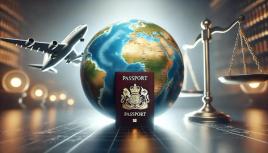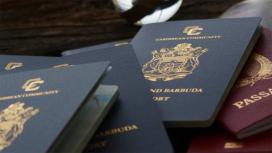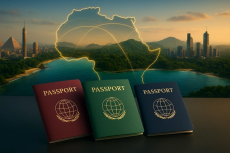Blog • Published on:October 17, 2025 | Updated on:October 17, 2025 • 13 Min
The Complete Guide to Citizenship by Descent in 2025
Citizenship by descent is one of the most direct legal routes to a second passport, based not on investment or residence, but on ancestry.
Under the jus sanguinis principle (“right of blood”), individuals can claim nationality through parents, grandparents, or earlier generations who held citizenship in a given country.
For many with European or Latin American roots, this path restores full citizenship rights, from EU residence and employment to access to education and healthcare, often without any physical stay or language requirements.
It’s a way to recover what was once lost through migration or naturalization and to secure long-term global mobility through family lineage.
This guide explains how the process works, which countries offer it, and what documentation and eligibility rules apply in 2025.
Understanding Citizenship by Descent
What Is Citizenship by Descent?
Citizenship by descent, or jus sanguinis, allows individuals to obtain citizenship through ancestral lineage rather than birthplace.
If one of your parents, grandparents, or even great-grandparents was a citizen of another country, you may be eligible to reclaim that citizenship, provided the lineage was never legally broken by renunciation or foreign naturalization.
This form of citizenship is recognized by many countries, particularly in Europe and Latin America, as a way to preserve cultural and familial ties across generations.
Benefits of Ancestral Citizenship
Acquiring citizenship through descent offers both practical and strategic advantages:
- Full legal rights — live, work, and study in your ancestral country without restriction.
- EU access (for eligible European programs) — free movement across all 27 EU states.
- Long-term security — permanent citizenship status that can be passed to future generations.
- No residence requirement — most countries do not require applicants to live in or visit during processing.
- Lower costs — generally limited to document authentication and administrative fees.
Difference from Other Citizenship Programs
Unlike citizenship by investment, which requires a financial contribution, or naturalization, which requires years of residence, citizenship by descent is a legal restoration of rights already belonging to your family line.
It is typically faster, less expensive, and more stable than any investment-based or residence-based alternative, though it demands precise documentation to establish the ancestral chain.
Popular Countries Offering Citizenship by Descent
Italy
Italy’s jus sanguinis framework is among the most inclusive worldwide.
Key facts:
- Generational limit extends to grandparents — citizenship is not only restricted to those with Italian parents
- Application channels: via Italian consulate abroad or directly in Italy (faster processing).
- Typical processing time: 2–4 years.
Ireland
Ireland’s descent pathway is both flexible and straightforward.
Eligibility:
- One Irish national parent → automatic citizenship.
- One Irish-born grandparent → citizenship through the Foreign Births Register.
- Registration enables the applicant’s future children to qualify automatically.
Main advantages:
- Full EU mobility rights and visa-free access to 180+ destinations.
- Access to both the EU and UK through the Common Travel Area.
Poland
Poland’s citizenship law recognizes descendants of citizens who held Polish nationality after 1920.
Requirements:
- Proof of an unbroken citizenship chain — ancestor must not have renounced or lost Polish nationality.
- Legal documents must include birth, marriage, and residence records verified by Polish archives.
Highlights:
- No generational limit if the lineage is continuous.
- Recognition of historical emigration, especially to the U.S., Canada, and South America.
Germany
Germany allows citizenship restoration and descent claims under distinct legal routes.
Main routes:
- Article 116(2): descendants of those stripped of citizenship during Nazi persecution.
- Standard descent claims for children of German citizens who never renounced nationality.
Key notes:
- Does not require residency or language test.
- Restitution claims processed through the Federal Office of Administration.
Spain
Spain offers citizenship by descent through multiple legal paths.
Options:
- Law of Democratic Memory: descendants of Spanish citizens who went into exile during the Civil War era (only available until October 22, 2025).
- Parent/grandparent route: possible with documentation of Spanish birth or nationality.
- Typical timeframe: 1–2 years depending on the route.
Eligibility Requirements for Ancestral Citizenship
Obtaining citizenship by descent is straightforward in concept but legally precise in execution.
Each country sets its own eligibility criteria, which determine how far ancestry can be traced and what evidence is required to establish an unbroken line of citizenship.
1. Generational Limits
Not all countries recognize citizenship beyond a certain number of generations.
- Unlimited: Hungary
- Up to grandparents: Ireland, Spain, Italy
- Special extensions: For example, Ireland allows great-grandchildren to qualify if their parent registered in the Foreign Births Register before their birth.
2. Proof of Lineage
Applicants must demonstrate a direct bloodline linking them to the ancestor.
Typical documentation includes:
- Birth and marriage certificates from each generation.
- Proof of ancestor’s citizenship at the relevant time (passport, ID, military service record, or census data).
- Legalized and translated copies of foreign documents where required.
3. Citizenship Continuity
Many applications are rejected because an ancestor renounced or lost citizenship, often when naturalizing elsewhere.
- Countries like Poland or Germany require that no ancestor in the chain gave up citizenship voluntarily.
- Applicants must check historical migration and naturalization records to ensure no break in status.
4. Residency or Cultural Connection (for some countries)
While most descent routes have no stay requirement, a few demand proof of continued cultural ties:
- Italy: Demonstrating a “genuine link” through family residence, community connection, or documentation.
- Greece and Croatia: Preference for applicants with language familiarity or recent family presence.
5. Language Requirements
Most countries do not require a language test, except a few such as:
Hungary: Basic conversational Hungarian for heritage-based citizenship.
Required Documents for Citizenship by Descent
The success of a citizenship by descent application depends almost entirely on documentation.
Governments require verified, official records to confirm every step of your ancestral line, from your own birth back to the qualifying ancestor.
1. Core Civil Documents
These form the backbone of your lineage proof:
- Birth certificates — for you, your parents, grandparents, and any ancestor linking the chain.
- Marriage certificates — to confirm family connections between generations.
- Death certificates — where relevant, to complete the family record.
Each document must clearly display names, dates, and places that match across generations.
Even small inconsistencies (like spelling differences or translation errors) can lead to delays or rejections.
2. Proof of Ancestor’s Citizenship
To confirm that your ancestor was legally a citizen of the country in question at the time, you’ll need one or more of the following:
- Passport, ID card, or national registry extract
- Military or tax records
- Census or residency certificates
- Immigration and naturalization documents (to show whether citizenship was retained or renounced)
3. Legalization and Apostille
All foreign documents must be authenticated for international use:
- Apostille certification (under The Hague Convention) is accepted by most countries.
- Consular legalization applies where apostilles are not recognized.
This ensures that your foreign-issued documents hold full legal validity.
4. Certified Translations
Any document not in the official language of the country must be translated by a sworn or certified translator.
Both the translation and the original document are submitted together.
5. Supporting Evidence
Some consulates or ministries may request additional documentation to strengthen lineage or identity claims, such as:
- Baptismal or parish records (for older ancestors)
- Historical property titles or census listings
- Family tree certified by a genealogist
- Court-issued name change or spelling correction documents
6. Apostille and Record Consistency Tips
- Ensure that all names, places, and dates match perfectly across generations.
- If spelling variations exist (e.g., anglicized names), submit notarized explanations or court affidavits.
- Collect duplicate official copies, as most countries retain originals during verification.
Application Process for Ancestral Citizenship
While every country has its own administrative procedures, the process for obtaining citizenship by descent generally follows a clear sequence.
Governments will only approve applications that demonstrate an unbroken and verifiable lineage.
1. Eligibility Assessment
Before collecting documents, confirm that your ancestry qualifies under the country’s citizenship laws.
- Review generational limits and rules on citizenship continuity.
- Verify whether your ancestor ever renounced or lost citizenship.
- Check if dual citizenship is permitted, most European countries allow it, but not all.
If needed, consult with a citizenship law specialist to interpret historic nationality laws and ensure eligibility before investing time in record collection.
2. Document Collection
Gather all the required civil and citizenship documents.
This includes birth, marriage, and death certificates for each generation, and proof of the ancestor’s original citizenship.
- Incomplete or mismatched records are the main cause of delays.
- When older documents are missing, contact national archives, church registries, or municipal offices in the ancestor’s country.
3. Legalization and Translation
After collecting the documents, complete the required legalization steps:
- Apply apostilles or consular authentications depending on the country.
- Translate all foreign documents into the country’s official language through certified translators.
- Verify that seals, names, and signatures are consistent across all translations.
4. Submission of Application
Applications are typically submitted either:
- At the consulate or embassy of the target country (for applicants abroad), or
- Directly through the Ministry of Interior or Immigration Office (for applicants applying in-country).
Each submission includes:
- The full document set,
- Completed application forms,
- Proof of fee payment, and
- A statement of claim linking the applicant to the ancestor.
5. Processing Period
Processing times vary widely:
- Ireland: 12–18 months (Foreign Births Register).
- Italy: 2–4 years (faster for in-country applications).
- Poland: 1–2 years, depending on document verification.
- Spain and Germany: 12–24 months on average.
Applications undergo verification by citizenship departments or archival review teams to confirm lineage accuracy and legal continuity.
6. Citizenship Confirmation
If approved, you’ll receive an official citizenship certificate or confirmation letter. After that, you can apply for a passport at your local embassy or consulate.
This grants full citizenship rights, including residence, employment, education, and inheritance privileges, identical to those of native-born citizens.
Dual Citizenship Considerations
One of the most strategic benefits of citizenship by descent is that most countries offering it allow dual nationality, giving you the flexibility to retain your existing citizenship while gaining a second one.
However, each country’s stance, and the implications for taxes, military service, and travel, should be reviewed carefully before applying.
1. Countries Allowing Dual Citizenship
Most European countries that grant citizenship by descent permit dual or multiple nationalities, meaning you can hold both passports legally.
- Fully permitted: Ireland, Italy, Portugal, Greece, Spain (in specific cases), Poland, Romania, and Hungary.
- Conditional or limited: Germany allows it for EU and Swiss citizens or if retention approval is obtained before acquiring another nationality.
- Restricted: Austria and the Netherlands generally require renunciation, except under specific circumstances (e.g., descent or public interest).
If you are a U.S. citizen, refer to our detailed guide on dual citizenship eligibility for current policies and implications.
2. Tax Implications
Dual citizenship may trigger tax obligations in both countries.
- Residence-based tax systems (like Ireland or Portugal) tax you only if you live there.
- Citizenship-based systems (like the United States) may tax global income regardless of residence.
Many applicants use tax residency planning to minimize double taxation, often supported by bilateral tax treaties between the two countries.
3. Military Service and Civil Duties
Some countries may still impose limited civic responsibilities on citizens by descent, even if they reside abroad.
- Mandatory service: Greece and South Korea maintain military service obligations for male citizens, though exemptions may apply for long-term non-residents.
- Exempt or symbolic duties: Most EU nations (like Italy, Ireland, and Poland) do not require military participation for citizens born abroad.
4. Passport and Travel Benefits
Holding two passports can transform global mobility and security:
- EU citizenship by descent grants visa-free access to over 180 destinations, including the Schengen Zone, the UK, and Japan.
- Non-EU options (like Argentina or Israel) expand access across South America and the Middle East.
- Some citizens also qualify for ETIAS-free entry in Europe, as explained in our ETIAS and Dual Citizenship guide.
5. Reclaiming Cultural and Legal Rights
Dual citizenship also reopens personal and financial doors, from reclaiming family property to qualifying for cultural scholarships or business grants in the ancestral homeland.
In many European countries, dual nationals gain automatic inheritance rights, easier property acquisition, and access to EU healthcare and education systems.
Common Challenges in Citizenship by Descent
While citizenship by descent is often considered the most accessible and affordable route to a second passport, it can be unexpectedly complex.
The process depends heavily on historical accuracy, record availability, and the specific laws of each country.
Below are the most common obstacles, and how to navigate them effectively.
1. Missing or Damaged Ancestral Records
Old records such as birth, marriage, or death certificates may have been lost, destroyed, or never digitized.
Wars, migrations, and poor archiving make it difficult to establish an unbroken lineage.
Solution:
- Contact national archives, parish churches, or municipal registries in the country of origin.
- Hire a professional genealogist or legal researcher to locate documents in local archives.
- Use alternate proofs such as census records, baptismal certificates, or property titles if civil records are unavailable.
2. Name Changes and Inconsistencies
Spelling variations or anglicized names often break the documented family chain.
Solution:
- Provide notarized affidavits or court declarations explaining the name variation.
- Submit both versions of records to demonstrate continuity.
- Ensure translations maintain consistent naming formats.
3. Ancestor’s Naturalization or Loss of Citizenship
If an ancestor renounced or lost citizenship before their descendant’s birth, eligibility may end. This is one of the most common disqualifiers.
Solution:
- Obtain naturalization or immigration records from the destination country.
- Determine the date of naturalization relative to your ancestor’s children’s births.
- Some countries, like Italy and Poland, have exceptions if the ancestor regained citizenship later or never formally renounced it.
4. Legal and Political Changes Over Time
Shifting borders or changes in nationality laws can make it unclear which state your ancestor legally belonged to.
Solution:
- Research the historical context, for example, ancestors from regions like Galicia or Silesia may fall under modern Polish or Austrian jurisdiction.
- Consult official archives or embassy legal units for confirmation of applicable laws during your ancestor’s lifetime.
5. Language and Apostille Errors
Incorrect translations or missing apostilles are among the top reasons for rejection.
Solution:
- Use certified translators approved by the target country’s consulate.
- Verify apostille validity (many expire after 6–12 months).
- Double-check that all seals, stamps, and notarial signatures meet the local legal standard.
6. Long Processing Times
Applications may take months or even years, especially in high-demand programs like Italy, Ireland, or Poland.
Solution:
- Ensure your file is complete from the start to avoid administrative pauses.
- If possible, apply directly in-country, many governments process local submissions faster than consular ones.
- Track application progress regularly with official channels.
7. Financial and Legal Costs
Even without investment requirements, the process can be costly once translations, apostilles, and legal assistance are added.
Solution:
- Budget realistically: legal fees and document expenses often total €1,000–€5,000, depending on complexity.
- Prioritize verified legal assistance for multi-generational or cross-border claims.
Reclaiming Your Roots Through Citizenship
In 2025, several governments are updating ancestry-based citizenship laws, making it easier for descendants to apply through verified documentation.
If you have European or Latin American heritage, this route can give you full citizenship rights, from living and working in your ancestral country to passing that citizenship on to your children.
Before applying, review eligibility carefully and gather accurate records. A clear family line and complete documentation can turn your ancestry into a tangible asset that supports global mobility, education, and legacy planning.
FAQs on Citizenship by Descent
How many generations back can I claim citizenship by descent?
This depends on each country’s law. Ireland allows claims through grandparents.
Countries like Poland and Germany typically recognize up to two or three generations.
Do I need to live in the country to apply for citizenship by descent?
In most cases, no. You can usually apply through a consulate in your current country of residence.
However, some nations, such as Italy or Spain, may prioritize or expedite applications submitted locally.
Is a DNA test required to prove ancestry?
No. Citizenship by descent relies on legal and civil documentation such as birth, marriage, and naturalization records.
DNA evidence is rarely accepted unless used to supplement incomplete records in exceptional cases.
Can I hold dual citizenship if I obtain citizenship by descent?
Most European countries that recognize ancestry-based citizenship allow dual nationality. Still, it’s important to verify whether your current citizenship permits it. You can review specific rules in our guide on dual citizenship eligibility.
What if my ancestor changed their name or naturalized elsewhere?
Name variations can be explained through affidavits or supporting legal documents.
However, if your ancestor renounced their original citizenship before their child’s birth, eligibility may be affected.
It’s best to verify historical citizenship status before starting your application.
References
Italian Ministry of the Interior. (n.d.). Citizenship by Descent (Jure Sanguinis) Guidelines. Retrieved from https://www.interno.gov.it
Government of Ireland – Department of Foreign Affairs. (n.d.). Citizenship through Foreign Birth Registration. Retrieved from https://www.dfa.ie
Federal Office of Administration – Germany. (n.d.). Acquisition of German Citizenship by Descent. Retrieved from https://www.bva.bund.de
Republic of Poland – Ministry of the Interior and Administration. (n.d.). Confirmation of Polish Citizenship by Descent. Retrieved from https://www.gov.pl
Government of Spain – Ministry of Justice. (n.d.). Spanish Nationality by Option or Descent. Retrieved from https://www.mjusticia.gob.es
Republic of Greece – Ministry of Interior. (n.d.). Greek Citizenship by Descent Procedures. Retrieved from https://www.ypes.gr
Written By

Andrew Wilder
Andrew Wilder is a multifaceted author on Business Migration programs all over the globe. Over the past 10 years, he has written extensively to help investors diversify their portfolios and gain citizenship or residency through innovative real estate and business investment opportunities.
Related Articles









Recently Published









Book a free consultation


